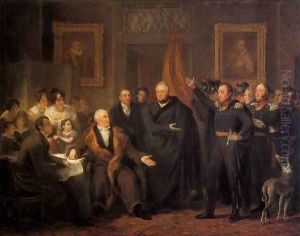Jan Willem Pienenman Paintings
Jan Willem Pieneman was a significant figure in the Dutch art world during the 19th century, known for his historical paintings and his role in the development of art institutions in the Netherlands. Born on November 4, 1779, in Abcoude, near Amsterdam, Pieneman developed an early interest in art, which led him to pursue a career as a painter. His work primarily focused on historical and military subjects, reflecting the turbulent times he lived in, including the Napoleonic Wars and the subsequent period of Dutch revival.
Pieneman was deeply influenced by the events of his era, and he sought to capture the heroism and complexity of these times in his paintings. One of his most famous works is 'The Battle of Waterloo' (1824), which depicts the decisive moment when the Duke of Wellington meets with Prince William of Orange, who was wounded in the battle. This painting, along with others like ‘The Self-Sacrifice of Pastor Antonius Hambroek on Formosa’ and ‘The Triumph of Prince Maurice at the Battle of Nieuwpoort’, not only showcases Pieneman's skill in depicting historical events but also his ability to convey the dramatic intensity and emotional depth of these moments.
Beyond his contributions as an artist, Pieneman played a crucial role in the Dutch art world as an educator and institution builder. He was a respected teacher at the Royal Academy of Fine Arts in Amsterdam, where he influenced a generation of Dutch artists. Additionally, he served as the first director of the Royal Picture Gallery, now known as the Rijksmuseum, in Amsterdam from 1844 until his death in 1853. In this capacity, he was instrumental in laying the foundations for what would become one of the most important cultural institutions in the Netherlands.
Pieneman's legacy is marked by his impact both as a painter of historical subjects and as a key figure in the Dutch art scene. His works are preserved in several museums across the Netherlands, including the Rijksmuseum, and continue to be celebrated for their historical significance and artistic merit. Jan Willem Pieneman passed away on April 8, 1853, in Amsterdam, but his contributions to Dutch art and culture remain enduringly significant.
